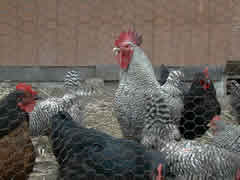 Avian Influenza (AI), commonly called bird flu, is a disease found in some populations of wild water fowl that can infect chickens, turkeys, pheasants, quail, ducks, geese and guinea fowl, as well as a wide variety of other domesticated and wild birds. Once AI is introduced into domestic avian populations, subsequent spread is normally caused by domestic bird-to-bird contact or through contact with contaminated people, feed or equipment rather than through secondary introductions from the wild reservoir.
Avian Influenza (AI), commonly called bird flu, is a disease found in some populations of wild water fowl that can infect chickens, turkeys, pheasants, quail, ducks, geese and guinea fowl, as well as a wide variety of other domesticated and wild birds. Once AI is introduced into domestic avian populations, subsequent spread is normally caused by domestic bird-to-bird contact or through contact with contaminated people, feed or equipment rather than through secondary introductions from the wild reservoir.
Each year there is a flu season for birds (just as there is for humans) and, as with people, some forms of the flu are worse than others. AI viruses can be classified as either low pathogenic avian influenza (LPAI) or high pathogenic avian influenza (HPAI) based on the severity of the illness they cause in poultry. Most AI strains are classified as LPAI and cause few clinical signs in infected birds. In contrast, HPAI causes a severe illness with a high mortality rate among infected birds. Because some LPAI strains have the potential to genetically change into HPAI, authorities will depopulate flocks infected with those strains of LPAI before they have the potential to change to HPAI and cause severe mortality.

